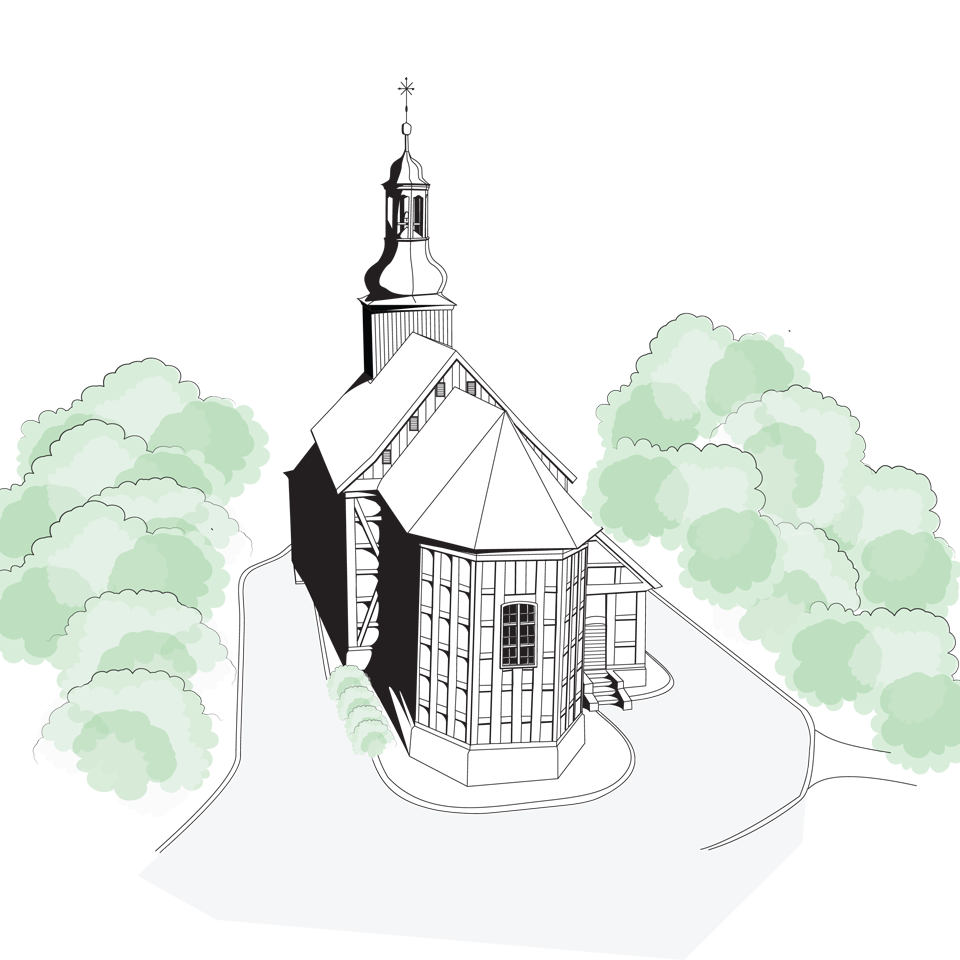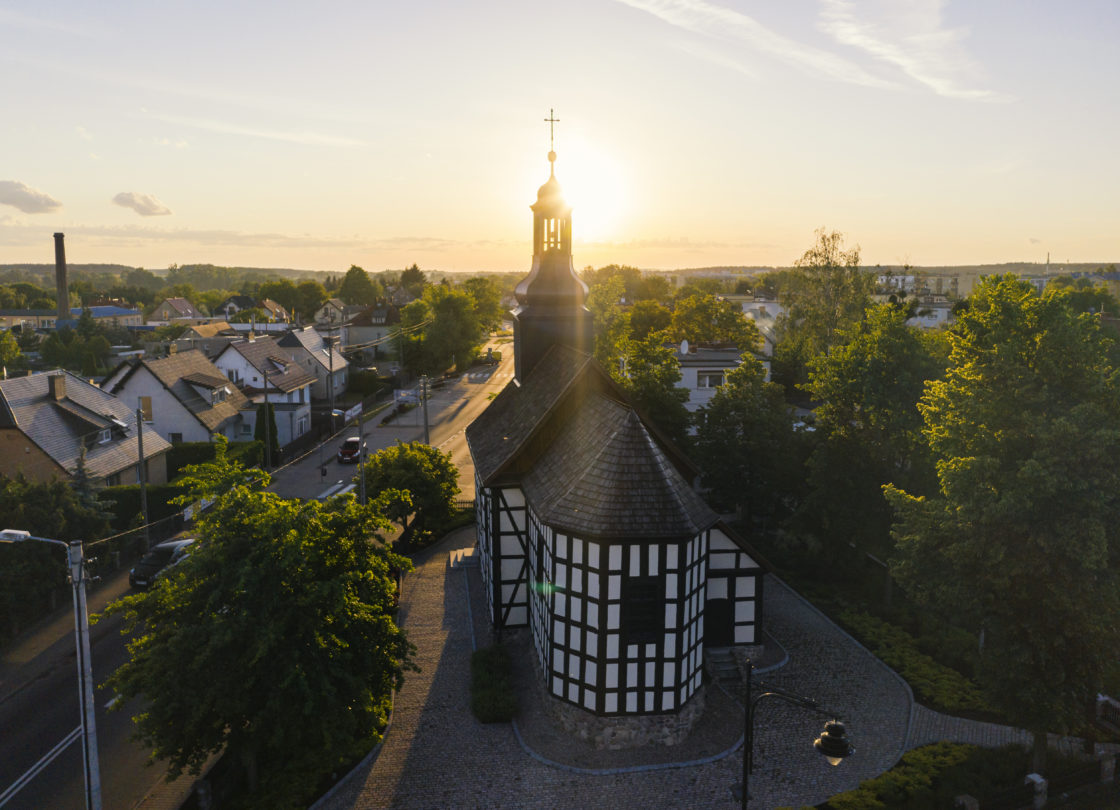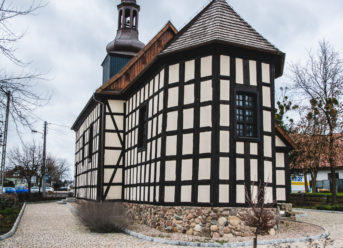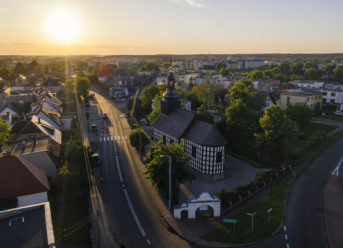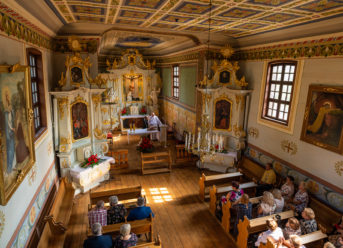Kościół pw. św. Krzyża
Die Kirche des Heiligen Kreuzes in Oborniki (die Filiale)
Church of the Holy Cross
Kościół filialny, należący do parafii Miłosierdzia Bożego. Zbudowany został w 1766 roku możnym gestem obornickiej mieszczki Łucji Łoyczykowskiej. Dla upamiętnienia tego wydarzenia, nad południowym wejściem do kościoła (od ulicy Obrzyckiej) umieszczono napis:
„Kościół niniejszy św. Krzyża wybudowano Roku Pańskiego 1766”
„Nie jest tu inszego nic, jedno Dom Boży a Brama Niebieska”
Kosztem Ł. Łoyczykowskiej.
Jednonawowy o konstrukcji szachulcowej z węższym prezbiterium i dobudowaną do niego zakrystią. Wieża zwieńczona barokowym hełmem. Wyposażenie późnobarokowe i rokokowe z okresu budowy kościoła. Ogrodzenie otaczające kościół zamyka piękna dwuarkadowa, późnobarokowa bramka. Najbardziej cennym elementem wyposażenia jest krzyż z ołtarzem głównym (ok. poł. XVI w.) z późnobarokową klęczącą postacią Marii Magdaleny, rokokowe ołtarze boczne: prawy z obrazem Matki Boskiej Bolesnej; lewy z obrazem Św. Rodziny oraz rokokowa ambona z trzeciej ćwierci XVIII w.
Podczas remontu wieży w 2015 roku odkryto kapsułę czasu. Umieszczona w miedzianej kuli pod krzyżem puszka skrywała dokumenty z 1883 r. dotyczące remontu i budowy świątyni. Z pisma dowiadujemy się, m.in. że kościół wybudowano w 1767 r., później uległ on zniszczeniu i odbudowywano go w 1832 r. Dopiero 51 lat później stawiano zaś wieżę z krzyżem. Na puszce, w której odnaleziono dokumenty, znajdowały się wyryte nazwiska „Grozmann” i „Kloss”. W piśmie zawarto informację, że Kloss był blacharzem i robił blachę na wieżę, Grozmann zaś budowniczym, który odpowiadał za jej powstanie. Skarb zabezpieczono, a w przebudowanej wieży umieszczono nową kapsułę dla potomnych. Znaleziska dokonano przy okazji pierwszej fazy renowacji całej świątyni, kolejne etapy realizowano w latach 2015-2020.
Die Filialkirche gehört zur Pfarrei der Barmherzigkeit Gottes in Oborniki. Sie wurde 1766 dank der Stiftung von der Bürgerin Łucja Łoyczykowska errichtet. Anlässlich des Kirchenaufbaus hat man über dem südlichen Haupteingang eine Inschrift angebracht, die an das Jahr der Kirchenentstehung und die großzügige Stifterin erinnert.
Der einschiffige, hölzerne Fachwerkbau besitzt eine wertvolle Einrichtung. Die Kirche enthält ein wenig engeres als das Schiff Presbyterium und eine Sakristei in Form des Anbaus. Der Turm ist mit einem barocken Helm gekrönt. Die Umzäunung der Kirche wurde mit einem Einfahrtstor mit zwei Arkaden geschlossen.
Im Kircheninneren ist ursprüngliche Spätbarock- und Rokokoausstattung erhalten. Besonders wertvoll sind das Kreuz und der Hauptaltar aus der Hälfte des 16. Jhs. mit der spätbarocken Statue der knienden Maria Magdalena. Ebenso sehenswert sind die Seitenaltäre: der rechte Seitenaltar mit der Darstellung der Schmerzensmutter und der linke Seitenalter mit dem Gemälde der Heiligen Familie. In der Kircheneinrichtung ist auch eine aus dem 18. Jh. stammende, im Rokokostil erbaute Kanzel zu sehen.
Bei der Sanierung des Kirchturms 2015 wurde in der Kupferkugel unter dem Kirchenturmkreuz eine Zeitkapsel aus dem Jahre 1883 entdeckt. Über 130 Jahren hätten in einer Büchse Dokumente aus den Jahren der Erbauung und der durchführten Renovierungsarbeiten gelagert. Dank diesem Fund konnte man erfahren, dass die Kirche 1767 errichtet wurde, dann zerstört und im Jahre 1832 wieder aufgebaut. Der Turm mit dem Kreuz kam erst nach 51 Jahren auf – im Jahre 1883. An der Außenseite der Büchse sind Namen "Grozmann" und "Kloss" eingeritzt. Die Dokumentation berichtet von den Renovierungsarbeiten - der Dachdecker Kloss bereitete das Turmblech vor und der Baumeister Grozmann erbaute den Kirchenturm. Um die Tradition der Zeitkapsel fortzusetzen, wurden alle Dokumente gesichert, sorgfältig aufbewahrt und nach dem Abschluss der derzeitigen Sanierungsarbeit (mit dem Schreiben an die Zukunft ergänzt) wieder in der renovierten Turmkugel eingeschlossen. Die Zeitkapsel wurde ganz am Anfang der Renovierungsarbeiten gefunden. Die gründliche Renovierung wurde in den nächsten Jahren weitergeführt und erst im Jahre 2020 vollendet. Die restaurierte Kirche glänzt heute in voller Schönheit.
Church of the Holy Cross - a branch church, belonging to the Divine Mercy Parish. It was built in 1766 and founded by a generous Oborniki townswoman Łucja Łoyczykowska. To commemorate this event, an inscription was placed above the southern entrance to the church (from Obrzycka Street):
"This church of the Holy Cross was built in the Year of the Lord 1766"
"There is nothing else here, one House of God and one Gate of Heaven."
„Founded by Ł. Łoyczykowska.”
Single-aisle, Wattle and daub style construction with a narrower presbytery and a sacristy added to it. The tower is topped with a baroque helmet. Late Baroque and Rocococo equipment from the church construction period. The fence surrounding the church is closed by a beautiful two-parcade, late Baroque gate. The most valuable items are the cross and the main altar (around the middle of the 16th century) with the late Baroque kneeling figure of Mary Magdalene, Rocococo side altars: the right one with the image of Our Lady of Sorrows; the left one with the image of the Holy Family and the Rococo pulpit from the third quarter of the 18th century.
During the renovation of the tower in 2015 a time capsule was discovered. Placed in a copper sphere under the cross, the box concealed documents from 1883 concerning the renovation and construction of the church. From the documents we learn that the church was built in 1767, later it was destroyed and rebuilt in 1832. It was not until 51 years later that the tower with the cross was built. On the tin in which the documents were found, there were engraved names "Grozmann" and "Kloss". The letter states that Kloss was a tinsmith and made metal sheets for the tower, while Grozmann was the builder who was responsible for its creation. The treasure was secured and a new capsule for posterity was placed in the rebuilt tower. The finding was made on the occasion of the first phase of renovation of the whole temple, the next phases were carried out between 2015-2020.
